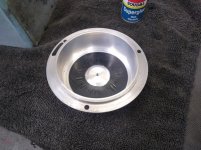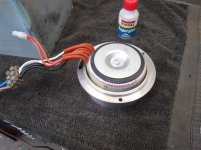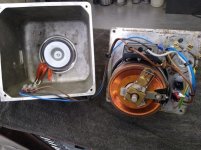Peter.
Titanium
- Joined
- Mar 28, 2007
- Location
- England UK
I'm currently re-wiring my HLV feed motor to use modern rectifiers to get rid of the old selenium rectifier for the armature and also to simplify the wiring. As part of that I'm tracing the wires and I've come across something odd.
The feed motor has on the tag: Volts 110A 200F, which obviously means 110V DC armature and 200VDC field. It's the only thing in the control box except for the LEFT-OFF-RIGHT switch which obviously sets the feed direction. I don't have an on-off switch or a lamp or a low-high switch like later machines, just these two things.
Just testing the vari-transformer without the new rectifiers fitted, I'm getting 0-230V when turning the dial full range. Now I'm wondering why my machine has been feeding over 200v into a 110v motor. Could this be a replacement motor of the wrong voltage? Were there motors on the early machines with field and armature both in the 200v range?
Schematics for the 1960's UK machines are thin on the ground, and most that I've found have the extra switches, some have resistors (I have none) and I'm unsure where to go with this. I don't want to cook my motor. I guess I could fit a buck transformer after the variable one to halve the voltage but I'm asking here before going that route.
Anyone have a clue what's going on?
The feed motor has on the tag: Volts 110A 200F, which obviously means 110V DC armature and 200VDC field. It's the only thing in the control box except for the LEFT-OFF-RIGHT switch which obviously sets the feed direction. I don't have an on-off switch or a lamp or a low-high switch like later machines, just these two things.
Just testing the vari-transformer without the new rectifiers fitted, I'm getting 0-230V when turning the dial full range. Now I'm wondering why my machine has been feeding over 200v into a 110v motor. Could this be a replacement motor of the wrong voltage? Were there motors on the early machines with field and armature both in the 200v range?
Schematics for the 1960's UK machines are thin on the ground, and most that I've found have the extra switches, some have resistors (I have none) and I'm unsure where to go with this. I don't want to cook my motor. I guess I could fit a buck transformer after the variable one to halve the voltage but I'm asking here before going that route.
Anyone have a clue what's going on?












